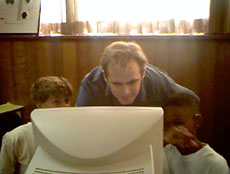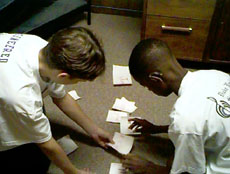|
July 14, 1997 With the third session of the Internet Explorers Club, project SUCCEED continues to run successfully. Fourteen students from throughout the Research Triangle Park area entered the doors of the Foundation's Durham office to begin an exciting exploration of science tools on the Internet. The session began today, July 14, at 8:30 am. The principal teacher of the IEC sessions, Joe South, began the day with an introduction explaining the the general theory of the program. This was followed by a short presentation from Dr. Robert M. Panoff, Bob1, the Foundation's Executive Director. Bob1 explained to the students the intentions of the Foundation.
"A special goal of the IEC workshop," said Bob1, "is to help you all understand that not everything you read in a book or find on the Internet is necessarily true. You have to learn to judge wisely." He then explained that most things we find on the Internet, just as in books, fall somewhere along a line that includes noise, signal, data, information, knowledge, and truth. All week long the students will be challenged to ask themselves and each other: "How do I know if it is right?" After the brief introduction of the Shodor Foundation the students then acted as if they were scientists. They would find out information about their partner by inquiring question about them such as a real scientist would. They would ask them questions such as: their experience with the Internet, their familiarity with the computer system, and personal information. This endeavor proved to be interesting and yet amusing to the students. Then intern Alton Patrick introduced the students to electronic mail, also referred to as e-mail. He helped the students set up their own personal e-mail account, and taught the students about e-mail security and e-mail etiquette. IEC students then began talking about how packets are sent across the Internet. Because the Internet is comprised of computers that transfer information through a network of different routes, the process of routing the information is very elaborate. The students then wrote a long message on a piece of paper. They then cut it into several smaller pieces of paper which were then sent them from one group to another. The intention of the exercise was that the pieces of paper be reassembled at their destination into their original format. After relaying the packets, students met to discuss packets. Joe asked questions about the packet "game" they were participating in. "I got the fastest packets that came to me," exclaimed the router Bobby. "In receiving the packets they usually come out of order....the pages are inputted with a binary number that the computer decodes on arrival," explained Joe South. Next, Anne Thissen prepared students to explore interesting science sites on the Internet. The Shodor staff, having composed a list of optional sites, let the students search the Internet free of non-essential instructions. NASA's BADweb site was a huge success. This site was created to help assist people in building their own simulated subsonic device via the Internet. NASA also included in the Internet simulation the market ticket price based on the cost of the air craft. Many IEC students were successful in completing the mission. Other recommended sites on the Internet that the students found interesting included the representation of light and reflection/refraction and the pH testing site. All in all, the Internet Explorers had a tremendously successful first day. The next few days should be full of opportunities for the students to explore and continue to learn about science through Internet-based activities.
Last Update: June 14, 1999 Please direct questions and comments about this page to WebMaster@shodor.org © Copyright 1998 The Shodor Education Foundation, Inc. |





